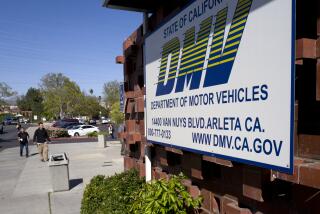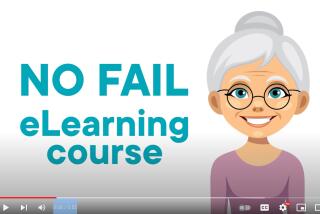Honk if You Love Road Kill
A quarter-century ago, back in the good old golden days of California public education, there existed a remarkable institution known as Drivers Training. The purpose of this taxpayer-supported program was to drill high school sophomores in the fine points of automobile operation--prior to turning them, and all their mixed-up glands, loose on the road. As a graduate, Class of ‘71, I remember Drivers Training mainly as a whole bunch of fun.
There were movies, classical works of gore (“Blood Alley,” etc.) meant to frighten young hotshots who otherwise would participate in back road drag races or drive under the influence of LSD. There were sessions in auto simulators. Students would sit in a mock-up cockpit, “driving” through all sorts of situations projected on a movie screen. It didn’t take long for certain mischief-makers to turn the exercise into a competition to determine who could run down the most pedestrians: Fun.
Finally, there were field excursions. We’d cram into a car with an assistant football coach and head for the highway. The constantly agitated coach would sit in the front passenger seat, one foot poised nervously on a special brake pedal, barking signals:
“Keep your hands in the 10-and-2 position. . . .
“Keep your head on a swivel. . . .
“Drive defensively. Plan your escape route. . . .
“Didn’t you see that truck!”
“Uh, gee, coach, what truck?”
*
Alas, Drivers Training as I knew it is no more--a money thing. Students at my old high school now must pay for private lessons, or wait until their 18th birthday to apply for a license. I wonder how they keep assistant football coaches occupied; surely they can’t all teach touch-typing. And while I have no solid information on whether the new system works any better than the old, I do have my doubts.
Last month I suggested here that, since everybody drives at 65 mph, it made sense--in an admittedly roundabout way--to keep the speed limit at 55 mph. Boosting it to 65 on thousands of miles of highway, as California and other states were preparing to do, would have the practical effect of raising the mean speed to 75 mph or so. It also, if some experts were correct, would lead to thousands of additional deaths.
Speed limits is apparently one of those subjects that gets people all fired up, unlike, say, the slaughter of innocents by gangs. Many dissenting readers felt compelled to write letters and set me straight. Their points were pretty much the same and ran counter to almost all the basic lessons of Drivers Training.
“People vote not only at the ballot box but with their right foot!” a sofa salesman from West Covina argued in what was the most comprehensive epistle on the subject. “They are not stupid or misinformed or retarded or possessed of a death wish, nor are they universally, perpetually drunk. They ARE willing to take a [presumed] risk for the very tangible increased convenience, pleasure and time savings. That is Their Right.”
He warned further about a “widespread disrespect for the law” under the old limits: “Not only do the majority of people speed indiscriminately, but worse, they do it safely, without negative consequences! . . . Give the public credit--they know the risks . . . and they choose to accept them. Why don’t you?”
*
Well, I’ll answer that last question. It’s because I still hear this growly voice of a high school line coach ringing in my ears. Driving, he is saying, “is a privilege, not a right.” For the whole mechanism to work for everybody, certain individual rights must be suspended. Thus, roadside sobriety checks. Thus, speed limits.
And yes, coach is saying, “You might be a terrific driver. Maybe you’re the next Richard Petty. So what? It’s the other drivers you have to watch out for; the way to stay alive on the road is to assume they are all drunken idiots. Keep your head on a swivel. Plan an escape route. . . .”
And so I consider it unwise to encourage drunken idiots to drive any faster than they already do. Which is why the 55-limit, sloppily enforced, seemed fine. Of course, the subject is moot. New speed signs have been posted. The flag is up. No longer will those who drive 65 mph feel like outlaws--at least until their speeds start edging up, as they inevitably will, toward 75 mph.
Many of my correspondents argued that this last point alone was cause enough to boost the speed limit: Since everybody broke the law, the law must be changed. To fail to do so, they reasoned, would only encourage a general disrespect for the law. The logic seems rather upside-down to me--rewarding anarchy to forestall anarchy--but nonetheless it’s a clever argument. I plan to use it myself, next time I’m audited.
More to Read
Sign up for The Wild
We’ll help you find the best places to hike, bike and run, as well as the perfect silent spots for meditation and yoga.
You may occasionally receive promotional content from the Los Angeles Times.






